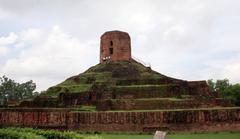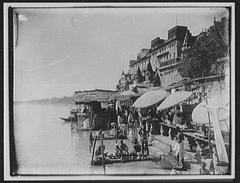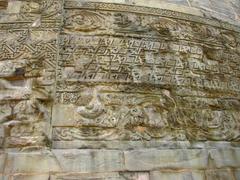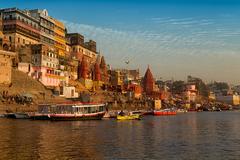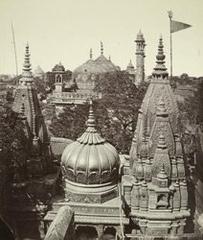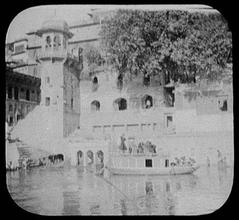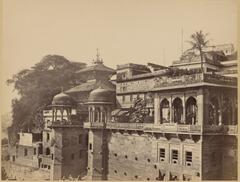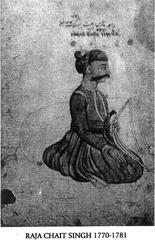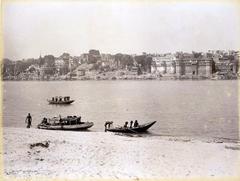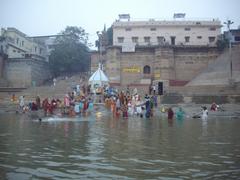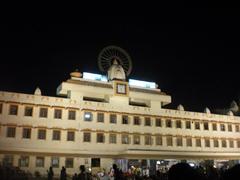Assi Ghat Visiting Hours, Tickets, and Historical Sites in Varanasi
Date: 16/07/2024
Introduction
Assi Ghat, located at the confluence of the Ganges and Assi rivers in Varanasi, India, is a site of immense historical, cultural, and spiritual significance. This comprehensive guide delves into its ancient origins, medieval prominence, colonial-era transformations, and modern-day relevance. Assi Ghat is not just a religious site but also a cultural and social hub, making it a must-visit destination for anyone exploring Varanasi.
The ghat’s name is rooted in ancient mythology, believed to have been created by the sword of Goddess Durga after she vanquished the demon Shumbha-Nishumbha. This mythological connection underscores the ghat’s significance in Hinduism, making it a vital pilgrimage site for devotees (source). During the medieval period, Varanasi flourished as a center of learning and spirituality, with Assi Ghat becoming a hub for religious activities and rituals.
The colonial era brought significant changes, with the British East India Company undertaking infrastructural projects to improve accessibility. Post-independence, the government initiated various projects to preserve and promote Varanasi’s cultural heritage, further enhancing Assi Ghat’s appeal (source). Today, it hosts various events, including yoga sessions, musical performances, and art exhibitions, reflecting its evolving role in Varanasi’s socio-cultural landscape.
Table of Contents
- Introduction
- Ancient Origins
- Medieval Period
- Colonial Era
- Post-Independence Developments
- Notable Historical Figures
- Architectural Evolution
- Cultural and Religious Practices
- Practical Visitor Information
- Preservation Efforts
- References in Literature and Art
- Conclusion
- FAQ
A Comprehensive Guide to the History and Significance of Assi Ghat in Varanasi
Introduction
Assi Ghat, located at the confluence of the Ganges and Assi rivers in Varanasi, India, is a site of immense historical, cultural, and spiritual significance. This guide will explore its ancient origins, medieval prominence, colonial-era transformations, and modern-day relevance. We will also provide practical information for visitors, including visiting hours, ticket prices, and nearby attractions.
Ancient Origins
Assi Ghat is steeped in ancient history and mythology. The ghat is mentioned in several ancient texts, including the Puranas and the Ramayana. According to legend, the ghat derives its name from the Assi River, which is believed to have been created by the sword of Goddess Durga after she slew the demon Shumbha-Nishumbha. This mythological connection underscores the ghat’s significance in Hinduism, making it a vital pilgrimage site for devotees.
Medieval Period
During the medieval period, Varanasi, including Assi Ghat, flourished as a center of learning and spirituality. The city attracted scholars, saints, and pilgrims from across the Indian subcontinent. Assi Ghat, in particular, became a hub for religious activities and rituals. The ghat’s prominence is evident from its frequent mentions in medieval literature and travelogues. For instance, the famous poet-saint Tulsidas is said to have composed parts of the Ramcharitmanas at Assi Ghat, further cementing its cultural and religious importance.
Colonial Era
The colonial era brought significant changes to Varanasi and its ghats. The British East India Company recognized the city’s religious significance and undertook several infrastructural projects to improve accessibility. Assi Ghat, like other ghats, saw the construction of steps, platforms, and other facilities to accommodate the growing number of pilgrims. The British also documented the ghat extensively, providing valuable historical records that offer insights into its condition and usage during the 18th and 19th centuries.
Post-Independence Developments
After India gained independence in 1947, Varanasi, and by extension Assi Ghat, underwent several transformations. The government initiated various projects to preserve and promote the city’s cultural heritage. Assi Ghat benefited from these efforts, with improvements in infrastructure and amenities. The ghat also became a focal point for cultural and religious events, attracting both domestic and international tourists. The annual Ganga Mahotsav, a cultural festival celebrating the Ganges, sees significant activities at Assi Ghat, highlighting its continued relevance in contemporary times.
Modern-Day Significance
Today, Assi Ghat is not just a religious site but also a cultural and social hub. It hosts various events, including yoga sessions, musical performances, and art exhibitions, reflecting the ghat’s evolving role in Varanasi’s socio-cultural landscape. The ghat’s historical and cultural significance has also made it a popular subject for academic research and tourism studies. Efforts by local authorities and NGOs to clean and maintain the ghat have further enhanced its appeal, making it a must-visit destination for anyone exploring Varanasi.
Notable Historical Figures
Several notable historical figures are associated with Assi Ghat, adding to its rich tapestry of history. The poet-saint Tulsidas, as mentioned earlier, is one of the most prominent figures linked to the ghat. His association with Assi Ghat has made it a revered site for his followers. Another significant figure is the 19th-century saint Trailanga Swami, who is believed to have performed several miracles at the ghat. His presence attracted numerous devotees, further elevating the ghat’s spiritual status.
Architectural Evolution
The architectural evolution of Assi Ghat reflects the broader changes in Varanasi’s urban landscape. The ghat’s steps and platforms have been rebuilt and renovated multiple times over the centuries, incorporating various architectural styles. The influence of Mughal, British, and modern Indian architecture is evident in the ghat’s current structure. These architectural layers offer a visual narrative of the ghat’s historical journey, making it a fascinating site for history enthusiasts and architecture aficionados alike.
Cultural and Religious Practices
Assi Ghat has been a center for various cultural and religious practices for centuries. The ghat is particularly famous for its morning and evening aarti (ritual of worship) ceremonies, which attract large crowds of devotees and tourists. These ceremonies, accompanied by chants, music, and the lighting of lamps, create a mesmerizing atmosphere that encapsulates the spiritual essence of Varanasi. Additionally, the ghat is a popular site for performing last rites and rituals, underscoring its importance in Hindu beliefs about life and death.
Practical Visitor Information
- Visiting Hours: Assi Ghat is open 24 hours, but the best time to visit is during the morning and evening aarti ceremonies.
- Ticket Prices: There is no entry fee to visit Assi Ghat. However, donations are welcome and go towards the maintenance and preservation of the site.
- Accessibility: The ghat is accessible by road and is well-connected by public transport. Wheelchair access is limited due to the steep steps.
- Nearby Attractions: Other notable ghats like Dashashwamedh Ghat, Kashi Vishwanath Temple, and the Banaras Hindu University are within close proximity.
- Special Events and Guided Tours: The annual Ganga Mahotsav and Dev Deepawali are major events held at Assi Ghat. Guided tours are available and can be booked through local tour operators.
- Photographic Spots: The steps of Assi Ghat, the confluence of the rivers, and the ghat during aarti ceremonies are popular spots for photography.
Preservation Efforts
In recent years, there have been concerted efforts to preserve and restore Assi Ghat. The National Mission for Clean Ganga (NMCG) and various local NGOs have undertaken initiatives to clean the ghat and the surrounding areas. These efforts aim to maintain the ghat’s historical and cultural integrity while ensuring it remains accessible and welcoming to visitors. The involvement of the local community in these preservation activities has been crucial, reflecting a collective commitment to safeguarding the ghat’s legacy for future generations.
References in Literature and Art
Assi Ghat has been a source of inspiration for numerous writers, poets, and artists. Its serene and spiritual ambiance has been captured in various literary and artistic works. The ghat features prominently in the works of renowned Indian writers like Munshi Premchand and R.K. Narayan, who have depicted its cultural and social milieu in their stories. Additionally, the ghat has been a popular subject for painters and photographers, who have sought to capture its timeless beauty and spiritual essence.
Conclusion
Assi Ghat’s rich history, spanning ancient mythology, medieval scholarship, colonial documentation, and modern-day cultural activities, makes it a unique and significant site in Varanasi. Its continued relevance in religious, cultural, and social contexts underscores its importance as a living heritage site. The ghat’s ability to adapt and evolve while retaining its historical essence is a testament to its enduring appeal and significance.
FAQ
Q: What are the visiting hours for Assi Ghat?
A: Assi Ghat is open 24 hours, but the best time to visit is during the morning and evening aarti ceremonies.
Q: Is there an entry fee for Assi Ghat?
A: There is no entry fee to visit Assi Ghat. However, donations are welcome and go towards the maintenance and preservation of the site.
Q: What are some nearby attractions to Assi Ghat?
A: Nearby attractions include Dashashwamedh Ghat, Kashi Vishwanath Temple, and Banaras Hindu University.
Q: Are there guided tours available for Assi Ghat?
A: Yes, guided tours are available and can be booked through local tour operators.
Q: What special events are held at Assi Ghat?
A: Major events include the annual Ganga Mahotsav and Dev Deepawali.
Call to Action
For more information on Assi Ghat and other historical sites in Varanasi, download the Audiala mobile app, check out related posts, or follow us on social media for updates.
References
- A Comprehensive Guide to the History and Significance of Assi Ghat in Varanasi, 2024, https://www.varanasi.org.in/assi-ghat
- Discover the Cultural and Historical Significance of Assi Ghat, Varanasi – Visiting Hours, Tickets, and More, 2024, https://www.culturalindia.net/indian-pilgrimage/varanasi/assi-ghat.html
- Exploring Assi Ghat - Key Attractions, Visiting Hours, and Cultural Significance in Varanasi, 2024, https://www.tripadvisor.in/Attraction_Review-g297685-d3705240-Reviews-Assi_Ghat-Varanasi_Varanasi_District_Uttar_Pradesh.html

